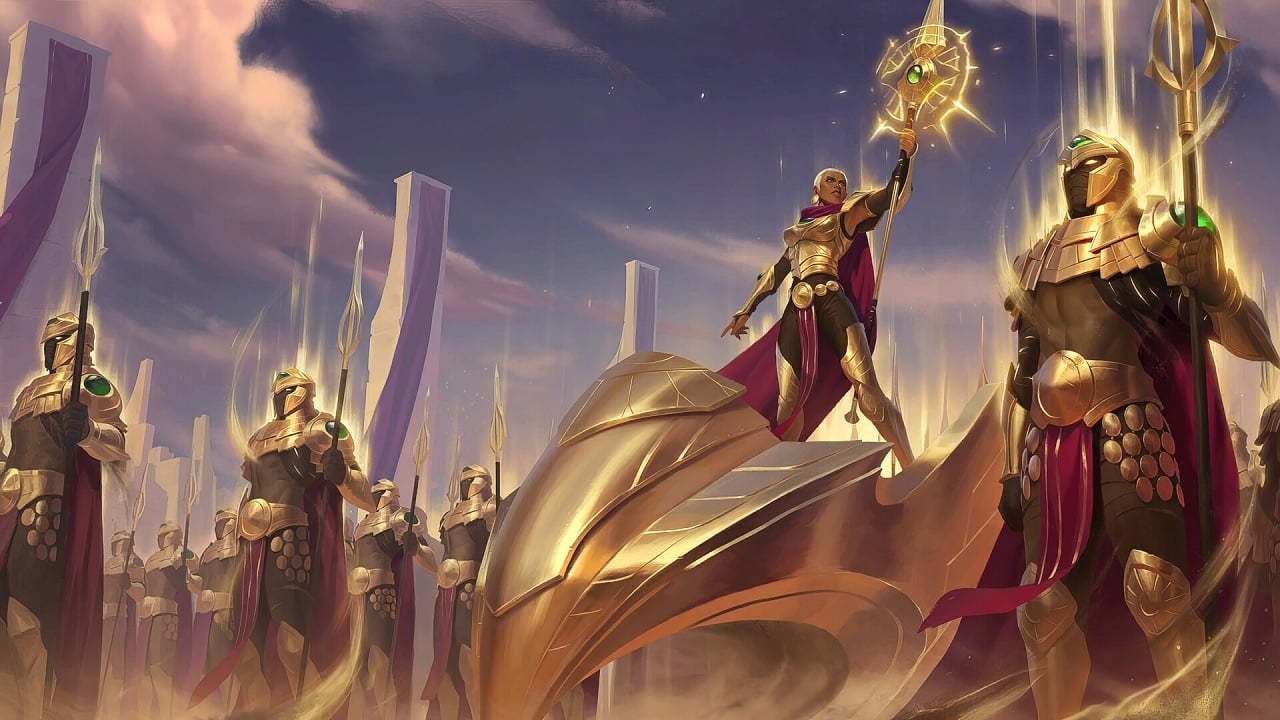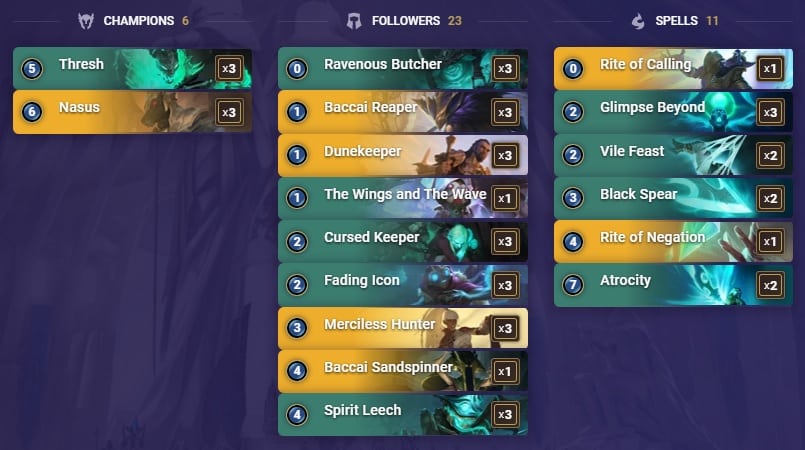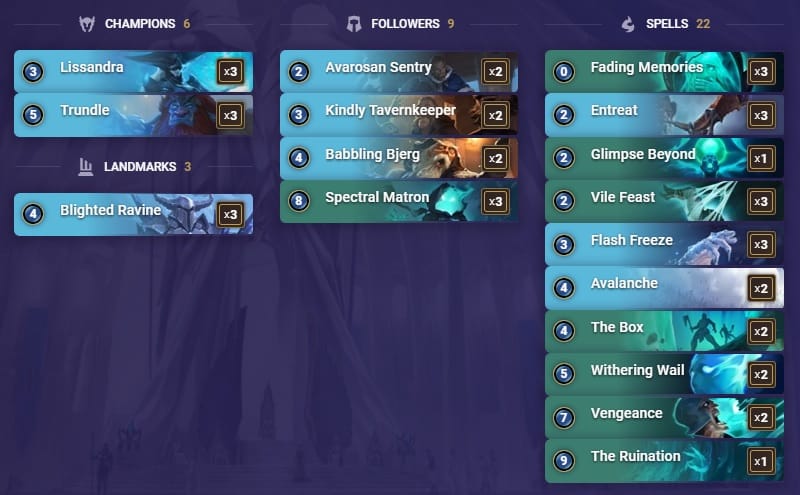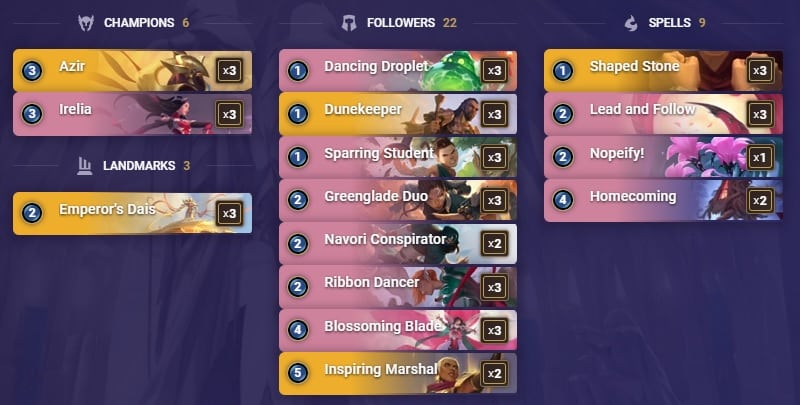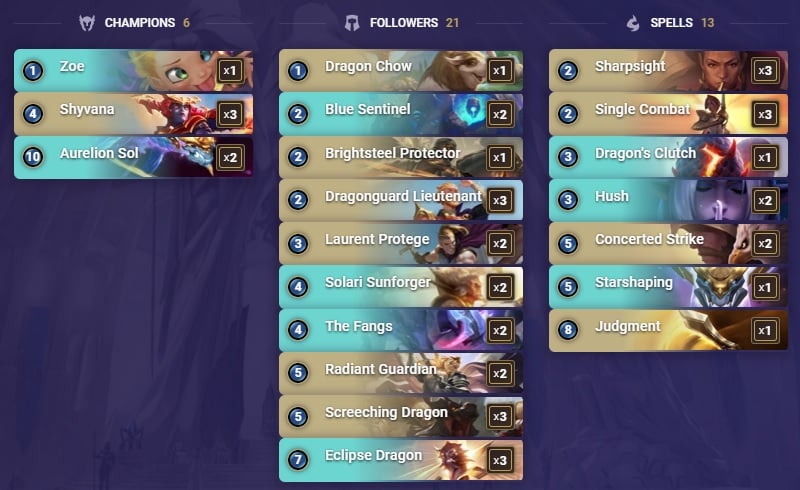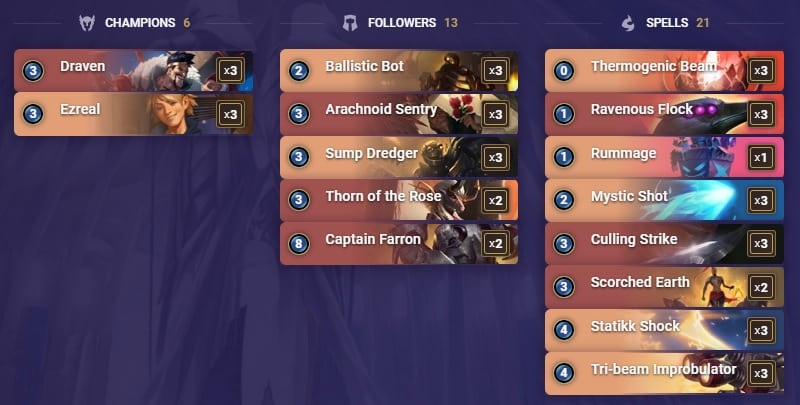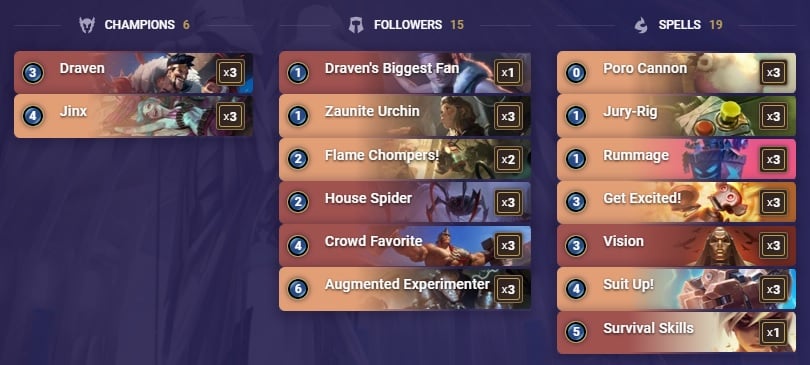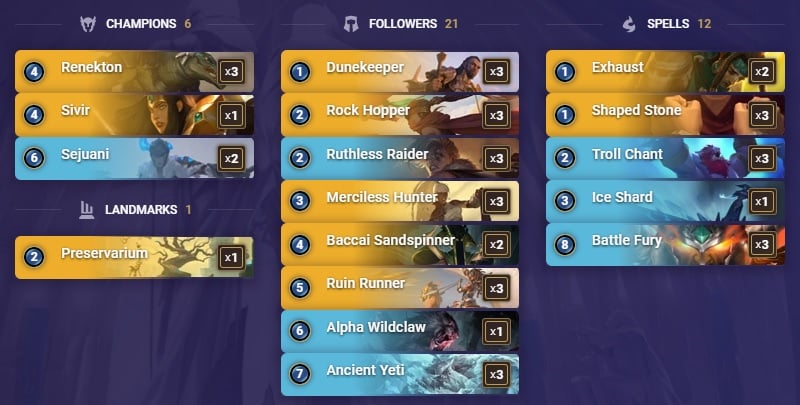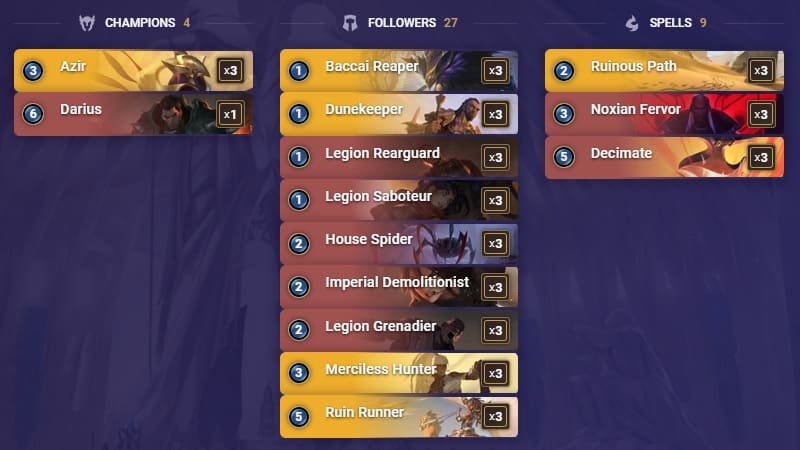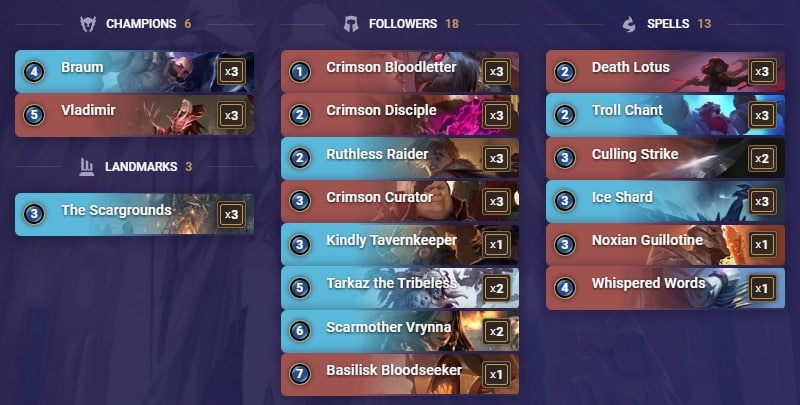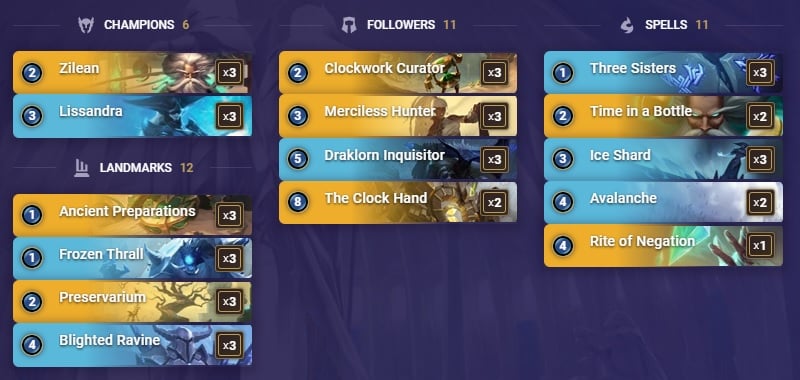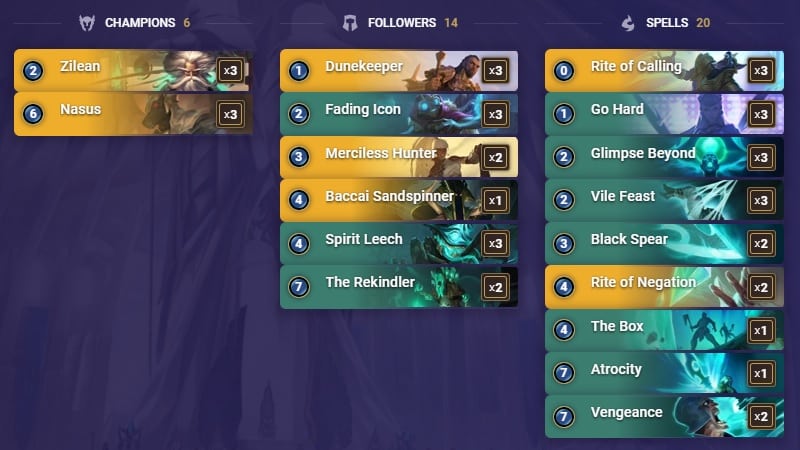Welcome to TLG’s latest meta snapshot for Legends of Runeterra, a series in which we give you our insight on the finest decks in the higher ranks of the ladder.
Every Monday, we discuss the decks that are part of the week’s meta and rate them on a scale of 1 to 5 stars. We also look at the evolution of said decks’ ratings across weeks and draw conclusions regarding the current state of the game, all of this so you can delve into your own ranked journey with a head start.
Nothing has changed this week, except for an incremental increase in the malaise caused by Azir-Irelia. We have updates for that list, if you choose to embrace the dark side, as well as for one of its counters in Dragons. Othal has also provided a spotlight discussing the state of the EU competitive scene in the run-up to another country-based Masters tournament.
We hope some good balance changes will reinvigorate the meta along with the mystery event arriving on the 19th May.
If you have any questions, feel free to drop by our Discord. Best of luck on your climb!
Graphics: WellMax81
Editing: Wusubi, Sebodunum
Writers: Den, Ultraman, Othal

CMBQEBAFAMIAIAIFBMYDCNAEAQDQEGRPM4AQGAIFDERCQAQBAQCQIAYEA45VC6I
Difficulty: Easy
Thresh-Nasus remains one of the best archetypes as of now, despite the nerfs to Atrocity and Blighted Caretaker. The addition of Merciless Hunter helps dealing with threats earlier (e.g. Ezreal) and allows you to make value trades, as her presence usually requires two cards from your opponent to be handled.
The early tempo of Ravenous Butcher, Cursed Keeper, Blighted Caretaker and Dunekeeper is still unmatched, granting you a great opener with which you can transition into Thresh. If your opponent failed to answer the early pressure every turn, they’ll have to kill both your minions and Thresh. This will force them into poor choices, proactive plays and suboptimal removals that you’ll be able to punish with Glimpse Beyond, Black Spear, Vile Feast or Rite of Negation.
And even if the opponent manages to withstand the early storm, they’ll still have to deal with Nasus. Depending on the deck you’re facing, Nasus can prove an insurmountable threat or a juicy Hush target. Either way, though, his pressure is undeniable and Atrocity will still obliterate the opposing Nexus, even if it costs one more mana now.
Ezreal-Draven especially struggles to answer Nasus - the deck can’t destroy him immediately, so he should be able to level-up and get Spellshield. Once this happens, you can kill them by responding to any spells thrown at you with Atrocity.
Thresh-Nasus also does quite well into Irelia builds, mainly by having access to a lot of early tempo, pressuring them while also taking advantage of the swarming Blade tokens playing directly into the hands of your champions. (Write-up by Ultraman)
Matchups:
Heavily favored vs Azir-Irelia
Favored vs Ezreal-Draven
Unfavored vs Dragons
Heavily unfavored vs TLC
CECACAYBAYBACAIBDUBAIAIFBYBQCBJIFQXQEAYBAUARGHIEAEAQGBYUGIAQEAIFB4YQ
Difficulty: Moderate
Most of the new decks that came out for now are aggressive builds that Trundle-Lissandra (TLC) can easily contain. Looking at our snapshot this week, there aren’t many decks TLC is afraid to face other than Azir-Irelia, which justifies the 4.5 star rating.
The deck doesn’t include new cards, and this list was used by Pespscola to win the latest EU Fight Night tournament. It doesn’t feel like anything new is needed for this deck to perform. The Freljord wide punish package prevents almost every swarm deck from development in the first 4 or 5 turns and Vengeance or the single copy of The Ruination is great help in the later stages of the game against Midrange builds.
TLC packs a lot of draw and can speedrun its combo against other slow decks, besides Deep can’t be found on ladder right now. Basically, TLC doesn’t fear most control-oriented matchups when it comes to reaching its win con first.
The showcased list has enough card draw to be able to play Spectral Matron on Turn 8 every game, which makes it a great pick for ladder, as the high-roll potential is matched with great stability. (Write-up by den)
Matchups:
Favored vs Thresh-Nasus, Dragons and Ezreal-Draven
Heavily unfavored vs Azir-Irelia
CMBQEAICAYVAIBAHAMNDGXIFAQBAIBIJBMHQGAIBAIWACAYCAUAQIBZZAEAQGAQU
Difficulty: Easy
Azir-Irelia has quickly become one of the most disliked decks in the history of the game, with crazy highs and frustrating lows, leaving players dissatisfied when both playing with it and against it. That said, we’re here to hook you up with what’s best, and this list is one of the very best as of now.
This deck is a relentless attacker, using (and abusing) Azir and Emperor’s Dais to create multiple tokens, swarming the board until your opponent has no blockers left to protect their Nexus. This could happen in two ways, either because your opponent overreacted and used too much of their precious mana, or simply because you had too many answers for their own responses.
Because, yes, this is Ionia. And as soon as you’re ahead, you get to dictate the pace of the game, forcing the opposition to play proactively, then punishing them for doing so. In the subtle words of BoJack Horseman’s writers:
“Are you punishing me for smoking or for stealing?”
“I’m punishing you for being alive.”
Azir-Irelia punishes you for being alive, basically. Until you aren’t anymore. They’ll punish you with the likes of Lead and Follow, Nopeify! sometimes Retreat if they run it, Shaped Stone... If you land a removal, you better celebrate.
The sole known way of defeating this great evil is, quite simply, outpacing it. Aggressive decks can do that and Thresh-Nasus can still do it better than anyone. The presence of Thresh as a tutor for Nasus also helps with stopping the waves of attackers, since even Ionia fears the power of the almighty Doggo. (Write-up by Ultraman)
Matchups:
Heavily favored vs TLC
Favored vs Dragons
Unfavored vs Ezreal-Draven
Heavily unfavored vs Thresh-Nasus

CIBQCAIADIAQGCLEAQBQABQIBMHAIAICAAAQCBAJAQBACAALB4CAGCJZKVL52AIDAECAADQCAEAAOCIDAMEQGCKU
Difficulty: Easy
Shyvana and her kin are trending, being able to answer Thresh-Nasus while retaining competitiveness against other popular decks, despite being statistically behind. Quite the conundrum, but fear not, all you have to do is replicate what the Top 10 players show you: play perfectly, and win. Simple recipe in theory, now for the practice...
This deck has ways of answering most opponents, but it requires you to anticipate most of their plays, as almost everything you do is heavy-handed in terms of mana and consequently doesn’t leave any room for error. One miscalculation can be the reason you won’t be able to use Concerted Strike on Turn 8, which can result in a threat getting through your blockers.
Blue Sentinel is strong at stopping the likes of Thresh-Nasus from attacking, as its potential to grant you a Shyvana on Turn 3 should be terrifying for the opponent. Your mid game is good, thanks to combat tricks such as Sharpsight, or just the regular Shyvana into Screeching Dragon play, helping you take back the board from your pesky opponent’s claws.
It must be said that Shyvana has bad matchups against most of the Tier 1 decks, statistically speaking, despite being built to resist the likes of Azir-Irelia, due to the Fury keyword and Radiant Guardian.
Make sure you mulligan for the early game, and don’t hesitate to greed in order to find your win cons. These are ASol against control decks, Hush vs Thresh-Nasus and Laurent Protege, Radiant Guardian or Shyvana vs Azir-Irelia! (Write-up by Ultraman)
Matchups:
Favored vs Thresh-Nasus
Unfavored vs TLC, Azir-Irelia and Ezreal-Draven
CECACAQDBEBAGBAFCEBQCAYECQXAKAIEDMPSIJRUAMAQCAZTAEBQGDIBAQBQUAIBAECAC
Difficulty: Easy
As each and every season, Ezreal-Draven shines as the anti-fun archetype, wheeled out by players wanting to stamp out those experimenting with new or unoptimized lists. Like a tough old veteran warming up the new trainees, this deck won’t take any of your bullshit. It’s strong and stable, with the ability to remove many threats and switch to more control or aggression-based gameplay depending on the deck it’s facing.
Matchup-wise, the ol’ man struggles against quite a few of the more-established decks, including TLC and Thresh-Nasus, but it compensates for this by utterly destroying any deck that tries to win through board pressure. Watch as the Demacians fall, one after the other, while Freljord Midrange suffers a similar fate.
Against your bad matchups, Ezreal will be your best bet, as he can take advantage of even the smallest window of opportunity once flipped to deal significant Nexus damage. If the opponent ignores him and tries to go for any combo play, you can punish them and take the game with the right tools in hand. (Write-up by Ultraman)
Matchups:
Favored vs Azir-Irelia and Dragons
Unfavored vs Thresh-Nasus and TLC
CECACAQEAMAQGBASAQAQGCIUE43QMAIEAEGRYJZIFUAQCAIEBQBACAIDEMAQGAYP
Difficulty: Moderate
Another patch, another day at the office for Discard Aggro. Thus far, the deck doesn’t look like the mean machine it has been in the past, but it’s still holding a good position in our ranking when it comes to its ability to climb the ladder. With very balanced matchups in the meta, Discard Aggro doesn’t really have a good reason to be played.
For now, Ezreal-Draven seems to be the better deck with the Noxus-PnZ pairing. It’s also true that Discard Aggro doesn’t have horrible matchups across the board either, and players looking for a comfort pick could find it to be the perfect archetype, as the deck is stable in what it does each and every game and packs enough pressure to outpace almost any deck.
With Irelia joining the battle, Ionia has become a more popular region, which is good news for Draven and Jinx, as Quick Attack is a nightmare to defend for the region. Since Ioania is incapable of removing her, Jinx can single-handedly win you the game from the back row if flipped early.
With Thresh-Nasus, TLC and Dragons looking like the early best trio, Discard Aggro doesn’t have great matchups to feed on, but it still looks like a better option than Shurima Burn, a deck that feels much more volatile in its gameplay. The never-ending draw power and constant pressure, mixed with Draven and Jinx’s capacity to be threatening in different ways, gives you the flexibility other Aggro decks don’t have at the moment.
For now, despite once again looking like the best damage archetype, Discard Aggro might look a bit lackluster compared to the new and shiny Irelia decks. However, time will tell us which aggressive mechanics will come out on top. (Write-up by den)
CMCACAQBAYAQGAICAIAQCBI7AYCAOGRGG5BV2ZYCAEBACAQCAQDS2UIDAEAQCGQBAQAQSAQEA4GRI
Difficulty: Easy
A deck that was a bit on and off last month is having a great start in May. With the addition of Merciless Hunter, Renekton has found one more ally to join his cause. Having an effective 3-drop gives the deck a much better curve and helps the Overwhelm mechanic pick its battles more effectively, which of course directly translates into achieving more Nexus damage over time and better trades in the Midrange matchups.
With average to good matchups against the current juggernauts (TLC, Thresh-Nasus, Ezreal-Draven) the deck looks like it could be a solid pick across the board, and several players have trusted it to climb the ladder or even to bring it to the latest edition of the Fight Night tournament (like Agigas or Saltysimon).
The list presented here is actually a mix of both these players’ decks, as Dunekeeper feels great instead of Omen Hawk (better blocking ability and 2 targets instead of 1 for a Battle Fury in the late game) and Ice Shard helps against all of the Aggro decks (Irelia, Discard Aggro, Shurima Burn) but can also help pushing more damage later on, weakening the opponent’s defenses to get more Overwhelm damage during an attack.
Lastly, in addition to Merciless Hunter, Baccai Sandspinner has also found its way back into the list, as the current meta features a lot of chump blockers that we can abuse once they’re given the Vulnerable status. This allows us to level Renekton or simply deal a ton of damage through a 1-health blocker.
If you’re looking to pick up this deck, I would recommend working on timing your attacks. It’s easy to go for big damage turns, but that can be at the sacrifice of the defensive part of the game, which is also very important to consider in order to ensure that you’re the one applying the pressure.
This will help you avoid entering into a damage race which isn’t so easy to win considering we have no healing and no direct damage from hand. Having good timing on when to start looking to push damage will allow you to keep your own allies and Nexus healthy, making a lot of decisions much easier down the line. (Write-up by den)
CIBAEAQCAMDAOAYJBENSGKBJGNOAIAIBAIYQCAYCCQAQIAQHAIBAEBIJAIAQEAQIAIBQSE2V
Difficulty: Hard
One more meta, one more Lee Sin deck to take into ladder and tournament play. The blind monk doesn’t look like he will slow down anytime soon, even though the deck cannot be compared to our Top 3 anymore, as it lacks in the defensive department against aggressive openings. Despite this, the deck remains a very decent overall pick.
Although only one new card has found its way into the build, Syncopation provides some nice surprises to our opponent. It can serve as a defensive card to get our most important unit out of a spell or a trade, as a damage push later in the game, or simply to force the opponent into trading one of our 2/1 Lifesteal units.
The big strength of the deck is its ability to adapt to the different matchups on the ladder, which can also be a weakness if our meta read was off. For now, Lee should be geared towards beating Ezreal-Draven while getting some help against Overwhelm and Aggro decks. This isn’t an environment that benefits the deck, which explains why you might not see it too much.
In tournaments however, the deck still performs well, as it was part of Pespscola’s winning line-up in the latest EU Fight Night. As the meta keeps on developing, we should gain more clarity on what the best decks are, which makes it easier to tech for the crucial matchups. (Write-up by den)
CMBQEAQDAMCAKAIDAIGCKKBXAYCAOAQDDI3VEZYAAEAQCAZG
Difficulty: Easy
What if I told you Burn decks are good in the earliest stage of a new meta? Surprising, right? The rush to Masters increases the playrate of such archetypes, as everybody is more focused on how fast they can climb rather than caring about their winrate.
Quick games is mainly what this deck has to offer, but it also has some redeeming qualities. The Overwhelm Midgame fits in with Shurima’s early game, making for more resilient minions after you damaged the opposing Nexus a bit.
Fight for the board as long as possible, but don’t sacrifice Nexus damage for board control, except if your opponent already has access to a lot of healing in their deck. Most of the time against other decks such as Ezreal-Draven, it’s better to go all-in on the damage and hope for good top-decks later on, or that they’ll miss their answers to Darius or Ruin Runner.
If you start engaging in trades, you’ll just die slowly as your opponent outvalues you. Mostly efficient against poorly-built decks, Shurima Burn punishes the early expansion greed in the best possible way: quickly, so you can climb rapidly. Once in Masters though, it’s best to shelve the deck and switch to something more flexible. (Write-up by Ultraman)
CEDACAIBBEAQEAIGAECACCIBAQBREAQDAEBBIBABAMDB4MBSAIAQCAYEAIAQCDIVAQAQCAJSAEAQGFQBAMBRCAIEAMBA
Difficulty: Hard
Have you ever heard of a deck which isn’t very good, but it has that one matchup where it feels impossible to lose? Well, when that easy matchup is against Irelia, it feels great to play such a deck. This week, that distinction goes to Braum-Vladimir.
Don’t get too excited, the deck isn’t a top tier contender or anything close to that, but if your goal is to deal with a flurry of small minions, then this is the deck you need. It should be seen as a counter-pick and not an overall good deck for laddering. Its linear gameplay and its need to find mechanics that it’s strong against limit it too much for it to shine on the grand stage.
I would personally recommend the deck if you’re in Platinum or lower, as the board control the deck offers plus Vladimir being tough to remove for a lot of decks and providing precious Nexus drain are two solid foundations for winning games. What the deck lacks to reach the higher tiers is some flexibility, as its removal package is limited to small units most of the time and the relative lack of draw is still a problem for the deck.
This list includes a copy of Whispered Words, which feels necessary even though it will have to be played at its full 4 mana cost in a lot of situations. Braum-Vladimir’s evolution will be based on how the meta progresses in the coming weeks, and the deck could either disappear or become the hottest pick available depending on what other decks will be popular. (Write-up by den)

CMBAKBAHBUOCOLDHAYCACAIFAYEQUDQCAEAQCFACAQDSEQQBAECAOOY
Difficulty: Moderate
Surprising to say the least, a Landmark archetype is finally viable. While Taliyah still searches for a deck that would accept her, Lissandra takes it upon herself to provide this deck with a win condition, set-up, trades and some early game. She can do it all, and trust me, she will!
She’s not helped much by Zilean, though, as he’s mostly there to contain aggression and be a removal target. That said, your opponent usually won’t be able to avoid answering his potential threat, because a flipped Zilean is a force to be reckoned with. Time Bomb, Avalanche and Blighted Ravine handle aggressive boards, while the Thralls slowly emerge from their icy tombs.
Their emergence can be accelerated thanks to Zilean’s spells, granting you an earlier access to multiple 8/8 Overwhelm units. Draklorn Inquisitor also will also help with this, freeing the Thralls from their deep slumber faster than expected.
Force your opponent into carefully answering each threat, until they either have no pressure left to stop you before Lissandra levels-up, or they misses a removal and you get to have a board full of gigantic minions. (Write-up by Ultraman)
CMCACAYFCABACBJIGEBAIBIDCACAIBY2E4XXSAQCAQDTWZYDAECQCFBCAIAQIB2RAIAQKEYZ
Difficulty: Easy
While the synergy between Go Hard and Zilean might seem a bit counter-intuitive, they both benefit from having a lot of card draw in the deck. The likes of Glimpse Beyond and Spirit Leech both help you course through Go Hard and Time Bombs as fast as possible in order to level-up Zilean. A flipped Zilean will be amazing, giving you more copies of Go Hard and Pack your Bags, allowing you to destroy the opponent’s board every turn.
The problem with this is that it takes a significant amount of time to level your Zilean. As such, you’ll often find the deck lacks consistency, or just ways of ending the game quickly. You’re able to handle aggression well, but usually end up losing ground against Midrange decks. Nasus is your savior in these matchups, allowing you to trade blows with enemies and force removals. Yet, even the almighty doggo will fall to Hush, Vengeance or Noxian Guillotine.
In order to stop these removals, you’re equipped with Rite of Negation, and a good, reliable Atrocity to steal a game there and then. In the full knowledge that Zilean and Nasus would make prime removal targets in the deck, The Rekindler comes in to bring them back to life.
The main problem is the lack of tempo, and as such, you’ll sometimes already be in a bad spot before Nasus or The Rekindler can come in and help you deal with the opposing board. Pack your Bags is your only hope in such situations, but it can prove difficult to rely on and set-up consistently. (Write-up by Ultraman)

If you’re following the Legends of Runeterra competitive scene, you’re aware that Riot announced the second edition of the LoR Masters Europe. This is a team competition where three players are chosen to represent their country from a single method of qualification: the Masters ladder.
To be selected, one must be amongst the Top 16 countries on ladder, and be one of the 3 best-placed players from this country. As you can imagine, the competition is rather fierce and will be raging on until the cut-off on 19th May. (Write-up by Othal)
But how does this impact the current meta and the state of the ladder? Even if this tournament doesn’t have the same reach as the Seasonal, it’s still one of the biggest competitions LoR has ever put together. While the selections for Seasonal are quite forgiving with the top cut being 700 plus a Last Chance Gauntlet, LoR Masters Europe is more exclusive with only 48 players being selected. These odds give a player looking for qualification zero margin for error.
As this announcement came with a new expansion, the meta could’ve been expected to shift towards new decks. But not only are these new archetypes unrefined, they also pale when compared to the current meta’s King & Queen: Thresh-Nasus and TLC. These decks are powerful, and the players have played them for more than a month. They had the time to improve, modify and adapt them as much as possible.
Their matchups are well-known and practiced, to the point that there are no surprises left for the players. As such, in a situation where every crumb of LP matters and each loss can disqualify a player or their country, it’s only logical that they would go back to these tried-and-true decks. Even Dragons, which saw a recent rise in play due to the prevalence of Azir-Irelia, isn’t a new deck and just needed the right meta to shine.
Refining decks takes a lot of trial and error, which means losing games, losing LP and losing ranks. Only a deck which combines raw power, high-roll potential and fast gameplay (like Azir-Irelia) could manage such a rise in the current meta. That’s why, until the cut-off date, you won’t be seeing any cheeky decks and creative builds on top of the ladder.

